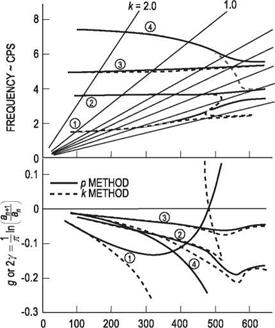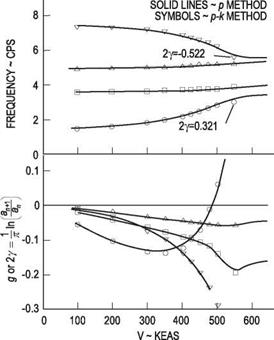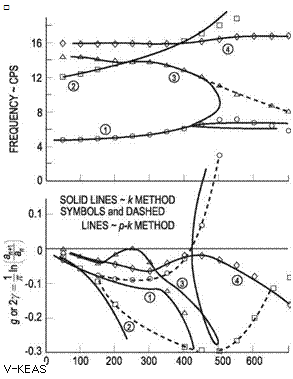The p-k Method
The к method is still popular in industry largely because of its speed. Although it provides significant advantages to the practicing aeroelastician, it is a mathematically
improper formulation. The impropriety of imposing simple harmonic motion with the introduction of artificial damping precipitated many heated discussions throughout the industry. It has been argued that for conditions other than the g = 0 case, the frequency and damping characteristics do not correctly represent the system behavior. As a result, design changes that are made based on these characteristics can lead to expensive and potentially dangerous results.
In 1971, Hassig presented definitive numerical results that clearly indicated that the к method of flutter analysis can exhibit an improper coupling among the modes of motion. His presentation utilized a simple form of unsteady aerodynamics in a к method analysis, and then he compared the results with those from a p method analysis. Recall that the p method presented in Section 5.1 is already established as the most accurate solution. Here, we show how both к and p-к methods relate to it.
In the p method, the general solution to the homogeneous modal equations of motion given by Eqs. (5.7) can be written in terms of a dimensionless eigenvalue parameter p = bv/U, where
fІ (t) = £ i exp(vt) (5.70)
Substitution of this expression into Eqs. (5.7) yields n + N linear, homogeneous equations for the n £is and the N Xs given as Eqs. (5.11). After eliminating the Xs using the second of Eqs. (5.11), we may rewrite the first of those equations symbolically as
where [‘M] and [юг-] are diagonal matrices with elements Ml, M2, …,Mn and «2, «2, respectively; n is the number of modes; and the unsteady aerody
namics operator matrix [A( p)] can be expressed in terms of the other matrices in Eqs. (5.11)—namely, in terms of [a], [b], [c], [d], [A], and [E]. The complex matrix [A(p)] is made up of so-called aerodynamic-influence coefficients (AlCs). These coefficients are functions of p and possibly of the Mach number, depending on the sophistication of the aerodynamic theory.
If the Xs are actually eliminated, then the problem, in general, cannot be expressed as a standard eigenvalue problem. This is not a serious obstacle, however, because we can always solve Eqs. (5.11) as a standard eigenvalue problem. The purpose here for eliminating the Xs is only to provide a convenient segue into the к and p-к methods and show explicitly the differences among the three methods. The important thing to note is not the procedure used to obtain Eq. (5.71); rather, it is the form of this equation that is most important at this stage. The coefficients A( p) frequently can be determined or identified in other ways. This equation is the basis for the p method in one of its usual forms. For a nontrivial solution of the generalized coordinate amplitudes, the determinant of the coefficient matrix in
 |
At selected values of reduced frequency and altitude, Eq. (5.75) can be solved for the complex roots of b2/ U2, denoted by Xr + iXi. These roots may be interpreted as
Xy + іXi = (1 + ig) (5.76)
where g is the structural damping required to sustain simple harmonic motion. This structural-damping parameter can be related to the rate of decay parameter of the p method as
g = 2y (5.77)
This is a good approximation for small damping as in the case of flight vehicles. The к method is posed easily as a standard eigenvalue problem, which is clear from Eq. (5.75). This alone gives it a significant advantage over the classical flutter – determinant method outlined in Section 5.3.
Another important aspect in making any correlation between the p and к methods is the matter of adequate inclusion of compressibility effects in the unsteady – aerodynamic terms. In the p method, the flutter determinant is solved for selected combinations of speed and altitude. Consequently, the appropriate Mach number can be used for the aerodynamic terms at the outset of the computation. In contrast, the к method preselects combinations of reduced frequency and altitude. As a result of then computing the airspeed as an unknown, Xr, the Mach number cannot be accurately specified a priori. The result is that an iterative process similar to the one described in Section 5.3 must be conducted to ensure that compressibility effects are adequately incorporated in the к method.
Figure 5.6. Comparison between p and k methods of flutter analysis for a twin – jet transport airplane (from Hassig [1971] Fig. 1, used by permission)
![]()
![]()
 Hassig applied the p and k methods of flutter analysis to a realistic aircraft configuration. By incorporating the same unsteady-aerodynamic representation in each analysis, he was able to make a valid comparison of the results. His observations are typified by Fig. 5.6 (which is his Fig. 1). Note from this figure that not only is the modal coupling wrongly predicted by the k method but also, more important, the wrong mode is predicted to become unstable. The only consistently valid result between the two analyses is that of the flutter speed for which g = у = 0. Despite the inconsistent modal coupling exhibited by the k method, it permits the use of simple harmonic modeling of the unsteady aerodynamic terms. As previously mentioned, the accuracy of simple harmonic airload predictions exceeds the accuracy of airload predictions for transient motions. It is for this reason that a compromise between the two models was suggested.
Hassig applied the p and k methods of flutter analysis to a realistic aircraft configuration. By incorporating the same unsteady-aerodynamic representation in each analysis, he was able to make a valid comparison of the results. His observations are typified by Fig. 5.6 (which is his Fig. 1). Note from this figure that not only is the modal coupling wrongly predicted by the k method but also, more important, the wrong mode is predicted to become unstable. The only consistently valid result between the two analyses is that of the flutter speed for which g = у = 0. Despite the inconsistent modal coupling exhibited by the k method, it permits the use of simple harmonic modeling of the unsteady aerodynamic terms. As previously mentioned, the accuracy of simple harmonic airload predictions exceeds the accuracy of airload predictions for transient motions. It is for this reason that a compromise between the two models was suggested.
The p-k method is such a compromise. It is based on conducting a p-method type of analysis with the restriction that the unsteady-aerodynamics matrix is for simple harmonic motion. Using an arbitrary value of k in computing [A(ik)], we find the flutter determinant to be
Given a set of initial guesses for k—say, ko = Ьщ /U for the ith root—this equation can be solved for p. Moreover, it can be posed as a standard eigenvalue problem for p because p appears only in a simple way. The typical result is a set of complex
Figure 5.7. Comparison between p and p-k methods of flutter analysis for a twin-jet transport airplane (from Hassig [1971] Fig. 2, used by permission)
 conjugate pairs of roots and possibly some real roots. Selecting one of the complex roots and denoting the initial solution as
conjugate pairs of roots and possibly some real roots. Selecting one of the complex roots and denoting the initial solution as
k = |ЭД| Y1 = ^p (5.79)
we can compute [ A(ik{)]. Using this new matrix in Eq. (5.78) leads to another set of ps, so that
k2 = p(p)! Y2 = (5.80)
k2
Continual updating of the aerodynamic matrix in this way provides an iterative scheme that is convergent for each of the roots, negative Y being a measure of the modal damping. The earliest presentation of this technique was offered by Irwin and Guyett in 1965. For low-order problems, it is straightforward to use a root-finding procedure in which the determinant obtained from setting k = |S(p) | is required to vanish.
Hassig applied the p-k method to the configuration in Fig. 5.6. As illustrated by Fig. 5.7 (which is his Fig. 2), the p-k method appears to yield approximately the same result as the p method. This, of course, simply validates the convergence of the scheme. Its greatest advantage is that it can utilize airloads that have been formulated for simple harmonic motion. Another comparison offered by Hassig was between the widely used k method and the p-k method for a horizontal stabilizer/elevator configuration. This example of a strongly coupled system provided the results given
Figure 5.8. Comparison between p-к and к methods of flutter analysis for a horizontal stabilizer with elevator (from Hassig [1971] Fig. 3, used by permission)
 in Fig. 5.8 (which is his Fig. 3). Here again, as in the к versus p comparison in Fig. 5.6, widely differing conclusions can be drawn regarding the modal coupling. In addition to the easily interpreted frequency and damping plots versus airspeed for strongly coupled systems, a second advantage is offered by the p-к method regarding computational effort. The к method requires numerous computer runs at constant density to ensure matching of the Mach number with airspeed and altitude. The p-к method does not have this requirement.
in Fig. 5.8 (which is his Fig. 3). Here again, as in the к versus p comparison in Fig. 5.6, widely differing conclusions can be drawn regarding the modal coupling. In addition to the easily interpreted frequency and damping plots versus airspeed for strongly coupled systems, a second advantage is offered by the p-к method regarding computational effort. The к method requires numerous computer runs at constant density to ensure matching of the Mach number with airspeed and altitude. The p-к method does not have this requirement.
The accuracy of the p-к method depends on the level of damping in any particular mode. It is left as an exercise for readers (see Problem 14) to show that the p-к method damping is only a good approximation for the damping in lightly damped modes. Fortunately, these are the modes about which we care the most. Methods presently used in industry are described by Goodman (2001). Currently, most flutter analyses in the aircraft industry are performed using к and/or p-к methods. Although the к method remains popular because of its speed, when accuracy is important and the p method is not feasible, industry users seem to favor the p-к method, especially those who run the NASTRANTM aeroelasticity package.











